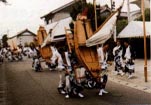
The Boat Ritual of Oe-Hachiman Shrine
(Sagara Town, Shizuoka)
Folk cultural properties reflect transitions in the daily lives of the Japanese people. They include tangible and intangible cultural properties that the people of Japan have created and passed down in the course of daily life, such as: manners and customs; folk performing arts and folk techniques concerning food, clothing, housing, occupation, religious faith, annual events, and other matters; and clothing, tools and instruments, dwellings, and other objects used in connection with the above.
The national government designates especially significant Folk Cultural Properties and strives to preserve them. For Important Tangible Folk Cultural Properties, the national government subsidizes projects concerning their restoration or administration projects to install facilities for storage and disaster prevention. The national government also subsidizes local governments for their efforts to preserve and pass down Intangible Cultural Properties and to generally utilize Folk Cultural Properties. The national government selects undesignated intangible folk cultural properties that need to be documented, and produces documentary records for them as necessary, or subsidizes research or documentation programs conducted by local governments.
Promotion of Documenting Endangered Intangible Folk Cultural Properties
The Agency selects and protects intangible folk cultural properties other than Important Intangible Folk Cultural Properties that particularly require documentation or other attention as “Intangible Folk Cultural Properties that need measures such as making records.” Among the selected intangible folk cultural properties, the ones with a higher risk of transfiguration or decay are systematically recorded in videos or reports, to ensure documentation.
1. Video documentation| Region | Name | Category | Date of selection |
|---|---|---|---|
| Fuyukizawa, Aizuwakamatsu City, Fukushima Prefecture | Prayer Tradition of Fuyukizawa | Manners and customs | December 3, 1999 |
| Ishikawa Prefecture | Noto Kiriko Festival | Manners and customs | December 4, 1997 |
| Gifu Prefecture | Ema Ichi Market in Hida | Manners and customs | December 4, 1997 |
| Aichi Prefecture | Omanto Festival in Aichi | Manners and customs | February 6, 2004 |
| Tottori and Shimane Prefectures | Hoki Kojin Festival, Izumo - Kojin Festival | Manners and customs | March 11, 2009 |
| Tokushima Prefecture | Fusuma Karakuri Tradition in Awa | Manners and customs | December 3, 1999 |
| Kagawa Prefecture | Umazekku Horse Seasonal Festival in Sanuki | Manners and customs | November 28, 1996 |
| Kagoshima Prefecture | Horse Dance Tradition of Satsuma | Manners and customs | February 12, 2002 |
* Click on the name to jump to the YouTube video channel of the MEXT.
2. Report
| Region | Name | Category | Date of selection |
|---|---|---|---|
| Aomori Prefecture | Mushi-okuri Tradition of Southern Aomori | Manners and customs | February 6, 2004 |
| Kamikoani Village, Kitaakita-gun, Kitaakita City, Akita Prefecture | Lantern Festival in Ani | Manners and customs | February 21, 2005 |
| Kashima City, Ibaraki Prefecture | Kashima miroku (8.1MB) | Folk performing art | March 11, 2009 |
| Nagano Prefecture | Kake-odori (dance dialogue) of Shimoina (8.8MB) | Folk performing art | December 3, 1999 |
| Shizuoka and Aichi Prefectures | Giant Kite Festival in the Tokai Region | Manners and customs | February 25, 1992 |
| Oto Village, Yoshino-gun, Nara Prefecture | Dance of Shinohara (7.4MB) | Folk performing art | April 21, 1971 |
| Tottori and Shimane Prefectures | Giant Kite Festival in the Sanin Region | Manners and customs | December 13, 1994 |
| Nagasaki Prefecture | Goto Kagura (sacred dance) (10.3MB) | Folk performing art | February 12, 2002 |
* Region indicates the region at the time of selection.







